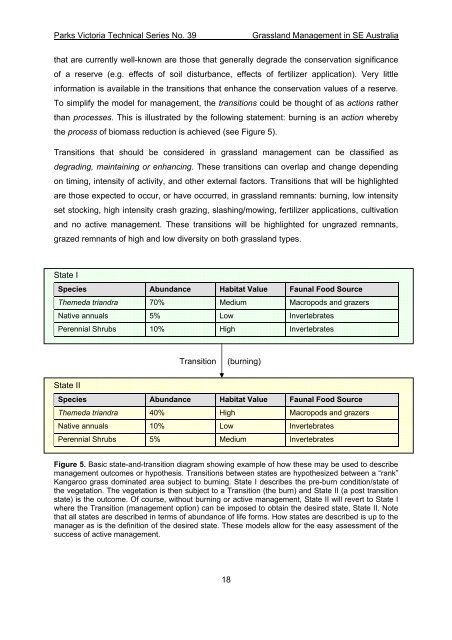Review of Grassland Management in south-eastern ... - Parks Victoria
Review of Grassland Management in south-eastern ... - Parks Victoria
Review of Grassland Management in south-eastern ... - Parks Victoria
You also want an ePaper? Increase the reach of your titles
YUMPU automatically turns print PDFs into web optimized ePapers that Google loves.
<strong>Parks</strong> <strong>Victoria</strong> Technical Series No. 39<br />
<strong>Grassland</strong> <strong>Management</strong> <strong>in</strong> SE Australia<br />
that are currently well-known are those that generally degrade the conservation significance<br />
<strong>of</strong> a reserve (e.g. effects <strong>of</strong> soil disturbance, effects <strong>of</strong> fertilizer application). Very little<br />
<strong>in</strong>formation is available <strong>in</strong> the transitions that enhance the conservation values <strong>of</strong> a reserve.<br />
To simplify the model for management, the transitions could be thought <strong>of</strong> as actions rather<br />
than processes. This is illustrated by the follow<strong>in</strong>g statement: burn<strong>in</strong>g is an action whereby<br />
the process <strong>of</strong> biomass reduction is achieved (see Figure 5).<br />
Transitions that should be considered <strong>in</strong> grassland management can be classified as<br />
degrad<strong>in</strong>g, ma<strong>in</strong>ta<strong>in</strong><strong>in</strong>g or enhanc<strong>in</strong>g. These transitions can overlap and change depend<strong>in</strong>g<br />
on tim<strong>in</strong>g, <strong>in</strong>tensity <strong>of</strong> activity, and other external factors. Transitions that will be highlighted<br />
are those expected to occur, or have occurred, <strong>in</strong> grassland remnants: burn<strong>in</strong>g, low <strong>in</strong>tensity<br />
set stock<strong>in</strong>g, high <strong>in</strong>tensity crash graz<strong>in</strong>g, slash<strong>in</strong>g/mow<strong>in</strong>g, fertilizer applications, cultivation<br />
and no active management. These transitions will be highlighted for ungrazed remnants,<br />
grazed remnants <strong>of</strong> high and low diversity on both grassland types.<br />
State I<br />
Species Abundance Habitat Value Faunal Food Source<br />
Themeda triandra 70% Medium Macropods and grazers<br />
Native annuals 5% Low Invertebrates<br />
Perennial Shrubs 10% High Invertebrates<br />
Transition<br />
(burn<strong>in</strong>g)<br />
State II<br />
Species Abundance Habitat Value Faunal Food Source<br />
Themeda triandra 40% High Macropods and grazers<br />
Native annuals 10% Low Invertebrates<br />
Perennial Shrubs 5% Medium Invertebrates<br />
Figure 5. Basic state-and-transition diagram show<strong>in</strong>g example <strong>of</strong> how these may be used to describe<br />
management outcomes or hypothesis. Transitions between states are hypothesized between a “rank”<br />
Kangaroo grass dom<strong>in</strong>ated area subject to burn<strong>in</strong>g. State I describes the pre-burn condition/state <strong>of</strong><br />
the vegetation. The vegetation is then subject to a Transition (the burn) and State II (a post transition<br />
state) is the outcome. Of course, without burn<strong>in</strong>g or active management, State II will revert to State I<br />
where the Transition (management option) can be imposed to obta<strong>in</strong> the desired state, State II. Note<br />
that all states are described <strong>in</strong> terms <strong>of</strong> abundance <strong>of</strong> life forms. How states are described is up to the<br />
manager as is the def<strong>in</strong>ition <strong>of</strong> the desired state. These models allow for the easy assessment <strong>of</strong> the<br />
success <strong>of</strong> active management.<br />
18

















